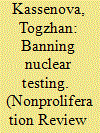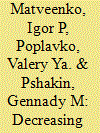| Srl | Item |
| 1 |
ID:
152058


|
|
|
|
|
| Summary/Abstract |
In the late 1940s, the Soviet Union rushed to build and test its first nuclear bomb to reach parity with the United States. The Soviet government chose the steppes of Kazakhstan as its first nuclear-testing site. In difficult conditions, weapons program participants built the site and, in 1949, tested the first Soviet nuclear bomb. Shrouded in secrecy, the Soviet military complex continued to conduct nuclear tests in Kazakhstan for forty years while the local population became an unwilling victim of the Soviet nuclear might. Nuclear tests, especially during the earlier years of atmospheric testing, resulted in severe health and environmental consequences for thousands of nearby residents. Mass protests in Kazakhstan against nuclear tests built the momentum that drove the Kazakh government's decision to close down the Semipalatinsk nuclear-testing site in 1989. Organized public movement against nuclear testing became an important part of Kazakhstan’s nation-building process. Since closing down the site, Kazakhstan has prioritized nuclear disarmament and nonproliferation, using its tragic nuclear past as a platform for making meaningful contributions to international security. Kazakhstan now offers the former nuclear-test site at Semipalatinsk for exercises designed to strengthen the verification capacity of the Comprehensive Nuclear-Test-Ban Treaty (CTBT). The country also plays a leading role in promoting CTBT entry into force.
|
|
|
|
|
|
|
|
|
|
|
|
|
|
|
|
| 2 |
ID:
124861


|
|
|
|
|
| Publication |
2013.
|
| Summary/Abstract |
One legacy of the Soviet nuclear program is great quantities of high enriched uranium (HEU) that were used in different research programs. The Institute of Physics and Power Engineering (IPPE), founded in 1946, was (and still is) actively involved in nuclear energy development and application, including fast breeder, naval propulsion and space power reactors. IPPE built a special experimental complex containing critical assemblies and research reactors. During 50 years of research activities, a great quantity of HEU fuel was accumulated. Some of the HEU is still used in critical assemblies, notably BFS (Fast Physical Stand) and a considerable amount of material remains in storage. Some HEU has been shipped off for blend-down and some could be used to fabricate new fuel with reduced enrichment levels. This article describes the issues related to reducing the use of HEU in IPPE research facilities-especially for the BFS critical assemblies.
|
|
|
|
|
|
|
|
|
|
|
|
|
|
|
|